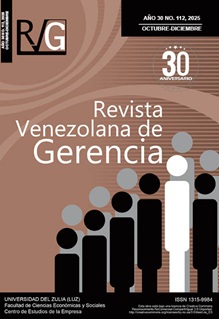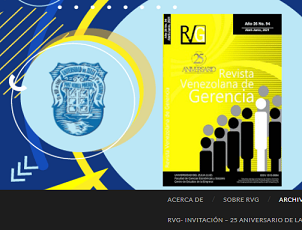Calidad del servicio y satisfacción del cliente de la Banca móvil cooperativista
Resumen
El estudio analizó la calidad del servicio y la satisfacción del cliente en los servicios de banca móvil de las cooperativas de ahorro y crédito de Chimborazo. La metodología utilizada tuvo un enfoque cuantitativo de tipo descriptivo y correlacional. Para llevarlo a cabo, se realizaron 384 encuestas estructuradas tipo Likert entre los cooperativistas donde el 58,7% correspondió al sexo masculino. El resultado del análisis factorial mostró una bondad de ajuste muy alta (KMO=0,904) y una confiabilidad alta (α=0,974). Por consiguiente, se evidenció la existencia de bajos índices de uso de aplicaciones de banca debido a la falta de confianza, seguridad y publicidad limitada. Se concluye que mejorar la seguridad y personalización de las aplicaciones fortalecerá la aceptación y confianza de los usuarios, al promover la inclusión financiera y la competitividad del sector.
Citas
Ahmed, S., & Zahid, H. (2022). The impact of perceived ease of use and perceived usefulness on customer satisfaction in mobile banking: Evidence from a developing economy. Journal of Financial Services Marketing, 27(3), 241–255. https://doi.org/10.1057/s41264-021-00126-8
Ajzen, I. (1991). The theory of planned behavior. Organizational Behavior and Human Decision Processes, 50(2), 179–211. https://www.sciencedirect.com/science/article/abs/pii/074959789190020T
Ajzen, I., & Fishbein, M. (1970). The prediction of behavior from attitudinal and normative variables. Journal of Experimental Social Psychology, 6(4), 466–487. https://www.sciencedirect.com/science/article/abs/pii/0022103170900570
Ávalos, V., Vallejo, L., Esparza, F., y Álvarez, M. (2019). Calidad del servicio: Técnica para mejorar el posicionamiento en las cooperativas de ahorro y crédito. MKT Descubre, 1(3), 296–306. http://revistas.espoch.edu.ec/index.php/mktdescubre/article/view/457
Benslimane, A., & Semaoune, K. (2021). An analysis of tourist’s behavioural intention in the digital era: Using a modified model of the reasoned action theory. International Journal of Marketing, Communication and New Media, 9(17), 1–24. https://doi.org/10.54663/2182-9306.2021.v9n17.4-26
Brazales, D. (2021). Estimation of the tourism crisis in Ecuador by COVID-19 with a view to a post-pandemic reactivation. Journal of Contemporary, 27(4), 91–110. https://doi.org/10.47750/cibg.2021.27.04.011
Carrasco, J. B. (2017). La influencia de los medios sociales digitales en el consumo. La función prescriptiva de los medios sociales en la decisión de compra de bebidas refrescantes en España [Tesis doctoral, Universidad Complutense de Madrid. Repositorio de la Universidad Complutense de Madrid]. https://eprints.ucm.es/42339/1/T38702.pdf
Chamorro, A., Bennet, J., y Revelo, L. (2023). Principales medidas económicas adoptadas por el sector empresarial durante la pandemia por COVID-19 en Colombia. Revista Criterios, 30(1), 93–111. https://doi.org/10.31948/rev.criterios
Davis, F. D. (1989). Perceived usefulness, perceived ease of use, and user acceptance of information technology. MIS Quarterly, 13(3), 319–340. https://doi.org/10.2307/249008
Gangwar, H., Date, H., & Ramaswany, R. (2015). Understanding determinants of cloud computing adoption using an integrated TAM-TOE model. Journal of Enterprise Information Management, 28(1), 107–130. https://doi.org/10.1108/IJBM-04-2019-0130
Gupta, K., & Arora, N. (2020). Investigating customer loyalty in online banking: A comparative study. International Journal of Bank Marketing, 38(3), 687–703. https://www.scirp.org/pdf/Oalib2025%2012null_1112891.pdf
Hassan, E., & Mahmoud, H. (2021). Orchestrating performance of healthcare networks subjected to the compound events of natural disasters and pandemic. Nature Communications, 12(1), 1–12. https://doi.org/10.1038/s41467-021-21581-x
Huang, R., Wang, J., & Guo, Y. (2022). Exploring the determinants of customer satisfaction and loyalty in mobile banking services: Evidence from China. Journal of Retailing and Consumer Services, 68, 103099. https://doi.org/10.1016/j.jretconser.2022.103099
Kaplanidou, K., & Gibson, H. J. (2012). Event image and traveling parents’ intentions to attend youth sport events: A test of the reasoned action model. European Sport Management Quarterly, 12(1), 3–18. https://doi.org/10.1080/16184742.2011.637173
Karabag, S. F. (2020). An unprecedented global crisis! The global, regional, national, political, economic and commercial impact of the coronavirus pandemic. Journal of Applied Economics and Business Research, 10(1), 1–6. https://www.scirp.org/(S(ny23rubfvg45z345vbrepxrl))/reference/referencespapers?referenceid=3458999
Madanoglu, M., Alhorr, H. S., & Najafi, N. (2023). Technology adoption and customer satisfaction in financial services: The mediating role of service quality. International Journal of Bank Marketing, 41(1), 52–70. https://doi.org/10.1108/IJBM-09-2021-0375
Maldonado, P. (2004). Módulo de Asistencia Técnica (TAM) Marco Integrado de Control Interno para Latinoamérica (MICIL) (Vol. 22314, Issue 01).
Noor, F., Ratna, D., & Triyanto, W. (2022). Appropriate application of Sawob M-Banking technology to develop waste bank management in Bae Village. Devotion: Journal of Research and Community Service, 3(4), 313–320. https://doi.org/10.36418/dev.v3i4.129
OCDE. (2016). El futuro de la productividad. OCDE.
Oliveira, T., Thomas, M., Baptista, G., & Campos, F. (2016). Mobile payment: Understanding the determinants of customer adoption and intention to recommend the technology. Computers in Human Behavior, 61, 404–414. https://doi.org/10.1016/j.chb.2016.03.030
Omar, S., & Cusairi, R. M. (2018). The use of plants in traditional medicine among the Siamese community in Kedah. Indian Journal of Public Health Research and Development, 9(11), 1672–1681. https://doi.org/10.5958/0976-5506.2018.01683.2
Pastor, A., Alguacil, M., y Alonso, M. (2016). Influencia de la calidad, satisfacción, valor percibido e imagen corporativa en la confianza en la marca en el servicio fitness. Revista de Psicología del Deporte, 25(1), 77–80. https://archives.rpd-online.com/article/view/v25-n3-pastor-barcelo-aguacil-etal.html
Patwary, A. K., Omar, H., & Tahir, S. (2020). The impact of perceived environmental responsibility on tourists’ intention to visit green hotel: The mediating role of attitude. Geojournal of Tourism and Geosites, 34(1), 9–13. https://doi.org/10.30892/GTG.34101-612
Peslak, A., Ceccucci, W., & Sendall, P. (2012). An empirical study of social networking behavior using theory of reasoned action. Journal of Information Systems Applied Research, 5(3), 12–22. https://iscap.us/proceedings/conisar/2011/pdf/1807.pdf
Pour, M. J., & Delavar, F. E. (2020). Developing a scale of social commerce service quality: An exploratory study. Kybernetes, 50(8), 2232–2263. https://doi.org/10.1108/K-06-2020-0373
Pramesty, I. N., & Ariesta, A. (2021). Business model canvas for usability testing of e-commerce website design using SEO on-page technique. Inform: Jurnal Ilmiah Bidang Teknologi Informasi Dan Komunikasi, 6(2), 93–102. https://doi.org/10.25139/inform.v6i2.3947
Pratiwi, E. D. (2016). Faktor yang mempengaruhi niat menggunakan instagram dengan the theory of reasoned action menggunakan amos 21. Journal Teknik Komputer Amik BSI, 2(1), 68–78. https://doi.org/10.31294/jtk.v2i1.364
Rahi, S., Ghani, M. A., & Alnaser, F. M. (2020). Predicting customer’s satisfaction and loyalty in mobile banking: A partial least squares (PLS) path modeling approach. Journal of Internet Banking and Commerce, 25(S2), 1–17. https://doi.org/10.1504/JIBC.2020.10004951
Salehudin, I., & Bagus, L. (2010). Marketing impact of halal labeling toward Indonesian Muslim consumer’s behavioral intention based on Ajzen’s planned behavior theory: Policy capturing studies on five different product categories Author. Proceeding of 5th International Conference on Business and Management Research (ICBMR), 1–18.
Sandage, C. H., Lee, J., & Lee, H.-S. (2014). Understanding consumers’ creating behaviour in social media: An application of uses and gratifications and the theory of reasoned action Chang-Dae Ham. International Journal of Internet Marketing and Advertising, 8(4), 241–263. https://experts.illinois.edu/en/publications/understanding-consumers-creating-behaviour-in-social-media-an-app
Sibai, M., Bay, B., & Rosa, R. (2021). Service quality and student satisfaction using ServQual model: A study of a private medical college in Saudi Arabia. International Education Studies, 14(6), 51. https://doi.org/10.5539/ies.v14n6p51
Strumska-Cylwik, L. (2019). The poverty of (critical) theory: A review. Acta Academica, 51(2), 93–99. https://doi.org/10.18820/24150479/aa51i2.5
Terry, D., Gallois, C., & McCamish, M. (2015). The theory of reasoned action: Its application to aids-preventive behaviour. En M. Argyle (Ed.), The theory of reasoned action: Its application to aids-preventive behaviour (Vol. 29, pp. 241-263). University of Bristol.
Toala, D., & Camino, B. (2016). Aplicación móvil para la inclusión financiera: Caso de estudio ventanilla móvil para la captación de depósitos en la Cooperativa de Ahorro y Crédito Santa Ana. En CONGRESO REDU 2016 (pp. 1–4). Universidad de las Fuerzas Armadas - ESPE.
Torres, P., & Luna, C. (2021). Calidad del servicio y satisfacción del cliente en la banca digital: Un análisis desde el modelo TAM. Revista Internacional de Negocios Digitales, 7(2), 45–60. https://doi.org/10.21015/rind.2021.72.45
Useche, M., Salazar, F., Barragán, C., y Sánchez, P. (2020). Horizontes estratégicos empresariales en América Latina ante la pandemia generada por la COVID-19. SUMMA, 2(Especial), 59–86. https://doi.org/10.47666/summa.2.esp.07
Vásquez, A. (2017). La influencia de la escuela de frankfurt en zygmunt bauman y richard rorty: De la teoría crítica a la modernidad líquida. Nómadas. Revista Crítica de Ciencias Sociales y Jurídicas, 50(1). https://doi.org/10.5209/noma.52424
Venkatesh, V., Thong, J. Y. L., & Xu, X. (2016). Unified theory of acceptance and use of technology: A synthesis and the roadmap for the future research. Journal of the Association for Information Systems, 17(5), 328–376. https://doi.org/10.17705/1jais.00428
Zhou, T. (2021). Understanding user satisfaction and continuance intention of mobile banking: An integrated model. International Journal of Mobile Communications, 19(3), 271–287. https://doi.org/10.1504/IJMC.2021.114568

Esta obra está bajo licencia internacional Creative Commons Reconocimiento-NoComercial-CompartirIgual 4.0.







.png)






























